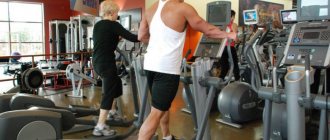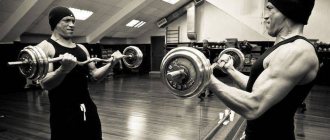Determining the initial load for a beginner
First of all, it should be noted that the weight of the apparatus in the exercise depends on the number of repetitions. The goal of the training (strength, mass or weight loss) is also of great importance. As a rule, beginners strive to increase muscle volume. In this case, the recommended number of repetitions in each approach will be in the range from 8 to 12. It is the “8-12” interval that provides the optimal time under load, which promotes hypertrophy of muscle fibers.
Methodology
So we know the quantitative rep range. Now you need to determine the starting weight. Let's say right away that the load should be such that the last 2 repetitions are performed with maximum effort. That is, each approach must be completed with muscle failure.
For example, let's take one of the most popular exercises - the bench press. If you have never done strength sports, start with an empty bar (20 kg). Do 20 chest presses. This will help stretch the muscles and joints of the arms, and will also allow you to assess your physical fitness.
If 20 reps with an empty bar are easy, feel free to add 10 kg on each side. In total you will get a barbell weighing 40 kg. Perform 12 lifts. If failure occurred in the “8-12” range, it means that in this exercise you were able to find the optimal starting weight.
If you couldn’t do even 7-8 chest presses, then you need to reduce the load. Reduce the total weight of the bar by 5 kg (remove 2.5 kg on each side) and repeat the set. In this way, you can choose the optimal weight load just for you.
If, after 12 lifts of a 40 kg barbell, you feel that you can do a few more repetitions, then you should increase the weight of the apparatus. We recommend using 5kg increments (2.5kg on each side) until you find the optimal load.
This method of “feeling” the weight should be used only in the first lesson. The next workout should begin not with an empty bar, but with the selected optimal value (of course, do not forget about the warm-up exercises).
The technique is suitable not only for bodybuilders, but also for athletes who want to develop exclusively strength characteristics. In this case, no more than 6 repetitions must be performed in each approach. And it’s best to start picking up weight not from 40, but from 55-60 kg.
Progression of loads
The growth of muscle mass occurs only with a regular increase in working weights. In this case, the basic rule - the onset of failure in the interval of “8-12” repetitions - must remain unchanged. That is, when the load increases, you cannot go beyond these limits.
So, let's take the already familiar example of the bench press. Let's say you have determined the working weight - 40 kg. That is, at the first training session, this exercise should be performed like this:
Warm-up: empty bar – 20 reps.
- 40 kg for 12;
- 40 kg at 11;
- 40 kg for 10;
- 40 kg for 10.
A gradual decrease in the number of repetitions is normal. It is associated with the consumption of glycogen (energy reserves in the muscles and liver). At the next workout for the pectoral muscles (in a week), you need to increase the weight of the barbell by 2.5 kg. That is, the execution scheme will look like this:
Warm-up: empty bar – 20 reps.
- 42.5 kg at 11;
- 42.5 kg per 10;
- 42.5 kg at 9;
- 42.5 kg for 8.
Please note that due to the increase in load, the number of repetitions in the approaches fell, but did not go beyond the “8-12” interval.
An important point is that you cannot increase the weight of the barbell every workout. Otherwise, this will most likely lead to the fact that in one of the approaches you will “jump” beyond the lower limit of the recommended interval, that is, you will not do even 8 repetitions. Increasing the weight of the apparatus should only occur when in the first 2 working sets you can do 12 full repetitions. Take your time, it may take 2-3 weeks. The optimal step for increasing weight values is 2-4 kg.
How to increase in training
When you don’t feel a surge of strength for a long time, and your results remain at the same level, this means one thing - you have reached a plateau in your capabilities. Strength is not growing, there is no progress, the mood is disgusting.
What to do? Be patient and keep training. Let the weights be the same, no problem. If you want, try increasing them by 0.5 kg, at a minimum. If you can't bear it at all, take a break for 1-2 weeks. Take up other sports, walk more, listen to your favorite music and allow yourself to enjoy life!
Also analyze your life. Maybe it’s not about sports, perhaps there are other reasons for frustration and poor health?
Recommendations for beginning bodybuilders
Selecting weight is not the only problem that beginners face. In order for your training to bring maximum benefit, and to increase the load regularly, we recommend paying attention to the following points:
- Technique. Correct execution of the exercise directly affects the increase in weight values. The fact is that with strict adherence to the technique, the muscles have a full load. As a result, strength indicators increase and muscle volume gradually increases, which inevitably leads to an increase in the weight of the equipment. If an athlete “cheats”, the target muscles do not receive enough useful load, which leads to stagnation in results and a decrease in the overall effectiveness of the training program;
- Psychological mood. Many aspiring bodybuilders face the fear of heavy weights. As a result, they begin to perform exercises with an unprepared psyche, which often leads to a slowdown in progress. Each approach must be approached in a “charged” state. Mentally prepare yourself to be able to lift the weight without any problems. If you are afraid of not being able to hold the projectile, be sure to use your partner’s belay. This will give you confidence when performing;
- Warm up. Scientists have proven that warmed muscles work much more effectively under load than during cold training. Consequently, after a good warm-up, the athlete performs the exercises more productively and gradually increases the weight values of the equipment. Warming up also helps reduce the likelihood of damage to joints, ligaments and tendons, making exercise safer. The only thing that should not be done before strength training is stretching;
- Nutrition. For muscles to grow, training alone is not enough. It is necessary to adjust the diet. The fact is that when performing exercises, muscle fibers receive micro-tears, which are subsequently overgrown with new tissue. This is exactly how a gradual increase in muscle mass occurs. But to maintain this process, the athlete must ensure that all the necessary nutrients are supplied. Recommended ratio in the diet: proteins – 40%, fats – 20%, carbohydrates – 40%.
It is very important to record the results achieved. To do this, we recommend keeping a diary in which you will record the exercises performed, the weight lifted and the increase in body weight. This is necessary so as not to be confused with the selection of load for each workout, as well as to visualize progress.
Determination of the initial load for girls
Many girls find it difficult to exercise with weights, even with an empty bar.
In most cases, this is due not only to muscle weakness, but also to low endurance of ligaments and tendons. Therefore, we recommend that such athletes perform exercises with light dumbbells and their own body weight for a large number of repetitions. It is this training scheme that will help strengthen muscles, ligaments, tendons and create a solid foundation for strength training. We offer an example of a 2-day training split for beginner athletes:
Upper body:
- Warm-up: jumping rope – 5 minutes;
- Push-ups from the knees – 3x10-12;
- Biceps curls with dumbbells (1-2 kg) – 3x15-20;
- French press with dumbbells (1-2 kg) – 3x15-20;
- Bent-over rows with dumbbells (2-3 kg) – 3x15-20;
- Hyperextensions – 3x15;
- Press crunches – 3x12-15.
Lower body:
- Warm-up: walking in an elliptical – 5 minutes;
- Squats without weight – 3x15-20;
- Swing to the side with a weight on the shin (1-2 kg) – 3x15-20;
- Cross lunges without weight – 3x15-20;
- Plie squats with a small weight (2-4 kg) – 3x15-20;
- Calf raises from a stand – 3x20;
- Raising the body on the press in a Roman chair – 3x12-15.
All exercises should be performed at an average pace. Pause between approaches - depending on how you feel. There should be 2-3 days of rest between workouts. After a month of regular exercise, we recommend gradually increasing the weight of the dumbbells (on average by 2-3 kg) and adding load to simple exercises. For example, you can do squats with a bodybar on your shoulders or do push-ups from a classic bench position. By the way, the considered training and weight selection scheme is also suitable for men whose level of physical fitness is at zero.
How to calculate working weight
As a rule, in bodybuilding they use 6-8 repetitions in each approach, this is the optimal number. Therefore, select a weight that you can lift 8 times, provided that the last repetition is a failure, first perform a warm-up weight with 50% of the expected working weight. The resulting figure will be the working weight. Remember that for 20% extra repetitions in trial sets, you need to increase the weight by 10%.
However, it should be noted that if you select the weight after several attempts, the final result will be lower, since the muscles will already be fatigued.
Calculation example:
- You assumed that in a trial set you can lift a 70 kg barbell 10 times.
- Do 1 set of 7 reps with 35kg. (Warm-up set)
- Lift the barbell as many times as possible. Let's say you get 12.
- You lifted 20% more times than expected, so the weight needs to be increased by 10%.
- Your approximate working weight is 77 kg. Check it out in your next workout and make adjustments.
Weight selection for weight loss
It is believed that the best type of training for burning subcutaneous fat is intense cardio.
Running, cycling, Nordic walking, active gaming disciplines, plyometrics - all this, when used regularly, helps to get rid of extra pounds. As a rule, the effectiveness of such types of fitness depends on the time spent under load. Experts recommend doing aerobic training for at least 50-60 minutes 4-5 times a week. Recent studies by Western scientists have shown that when combining strength training with aerobic exercise, the rate of fat burning increases. This means that the most effective weight loss regimen combines gym fitness and cardio training. In this case, determining the weight of the shells is a strictly individual factor. It is necessary to choose a load that will allow you to do 15-20 full repetitions in each approach.
The basis of a fat burning program should be strength elements: deadlift, squat, chest press. These exercises should be distributed over 3 workouts per week. The initial weight of the weights should be small (for example, an empty 20 kg bar). Girls are allowed to do Romanian deadlifts with dumbbells instead of deadlifts. Additional exercises are performed at a fast pace. On rest days, you should do 60-minute cardio sessions (2-3 times a week).
When to increase weight: the “two for two” rule
Pete Bellis/Flickr.com
If you're looking to increase muscle mass, you'll likely be using low reps and heavy weights close to your one-time max.
It is important to understand here that in order to progress, the weight must be such that the last repetition in the set is on the verge of muscle failure. The “two for two” rule allows you to determine when you stop exercising to the point of muscle failure.
This rule was proposed by Thomas Baechle in the book Essentials of Strength Training and Conditioning. This is what it sounds like.
If you can do two more reps on the last set of any exercise, and you do it the last two workouts, it's time to increase the weight.
For example, let's say you do 4 sets of 8 reps of dumbbell curls. If you can do 10 reps on your last set two workouts in a row, it's time to increase the weight.
There is another, faster option for increasing working weight - a scheme of fixed approaches.
Training after a long break
The approach to strength training after a break should be meaningful and gradual. If the duration of the break does not exceed 6 months, then you can safely use the previous training plan. The only conditions are to reduce the weight load by 50% and increase the maximum number of repetitions in a set from 12 to 15. With this training regimen, as a rule, it is possible to increase the working weight in exercises by 5-7% every week without any problems. As soon as the indicators reach their previous values, you can switch to the classic training scheme.
For those who are in the hall for the first time
If this is your first time coming to the gym, you need to take into account your preparation. Often there is none at all. How to determine the working weight in this case? So far, no way.
People go to swing because they “already have the urge.” Therefore, the first training session is a very important moment. If you get a bad impression from (or after) her, you won’t come here a second time.
Usually the number of approaches and weight are selected by the trainer. Wait! Does the trainer have the necessary education and courses? Or is he just a home-grown muscleman who has achieved rapid progression through bad means? They are the ones to be afraid of.
The first training session should be an introductory one. We recommend not selecting weights yet, but taking what is not heavy for you at the moment. That is, if it’s a barbell, then it’s one that you can easily lift. After all, you will be lifting the barbell repeatedly, so even the weight that seems too light to you for one concept will put a noticeable load on the muscles. This is important not only for beginners, but also for guys weakened by a long break.
So, why is it important to work with minimal weights in the first workout:
- Your muscles don't know what hardware is.
- You don't have enough stamina yet.
- You don't know the technique of doing the exercises.
Simply put, you will easily get a sprain, or your muscles will be sore for a week after training. Believe me, after this the second time you are unlikely to want to come to the gym.
Correct selection of weights at the first visit - an empty bar for bench presses, dumbbells 2-5 kg for other exercises. If you want to squat, use an empty bar. Learn technique! And if the trainer tells you that the weight is light and you need to add more, don’t listen to him. This is the first training session.
There have been many cases when, after such training, a person has a fever for a week, and he cannot bend or straighten his arms. Why do you need this?
The first workout is a minimum of weights. The same goes for the number of approaches. We recommend doing 2 approaches. But you can get the program from the trainer. Or have a trainer show you what to do that day.
Example for beginners
The trainer told you to do 3 sets of all exercises. Reps: 10-15. Your task is to do 2 sets with the same number of repetitions. For bench press/squat/deadlift, it is better to take an empty bar or add 10 kg. Arm flexion-extension, dumbbell press – 5-6 kg. And isolated shoulder exercises are best done with 3-4 kg. You will understand why.
If everything comes very easily, most likely you are doing it wrong. In the case of dumbbell lateral raises, for example, if it’s easy for you, then most likely you bend your arms too much, or you haven’t turned your elbows up. Incorrect technique is easier to do. Remember!
Recommendations for athletes
In addition to a gradual “soft” entry into the training process, you need to pay attention to the following points:
- Imbalance. Having resumed training, the athlete quickly restores strength indicators. This is due to the developed neuromuscular connection and prepared nervous system. The problem is that joints, ligaments and tendons are not able to adapt as quickly to increasing loads, since they have a denser structure. As a result, such tissues begin to lag behind in development, which can lead to injury. The main recommendation in this case is not to rush into weight progression;
- Intensity. In the first 2-3 months, you should not perform exercises with maximum intensity. It is advisable not to push the muscles to failure at all. This stage should be characterized by moderate loads, allowing you to strengthen the body, but without “burning” in the muscles. This is due to the fact that during rest the body “gets out of the habit” of accumulating large amounts of glycogen. As a result, ultra-intense exercise can lead to rapid acidification of muscle fibers and a decrease in the effectiveness of training;
- Sports nutrition. After a long pause, we recommend using various supplements. If you feel like you don't have enough energy for even moderate-intensity workouts, buy creatine. This substance promotes water retention in the body, which helps overcome weakness. In addition, during the recovery period, it is advisable to use preparations containing collagen and elastin for ligaments and tendons. We also recommend purchasing a vitamin complex for quick recovery and good health.
As a rule, experienced athletes achieve their previous strength and form in 6-8 months. At the end of this interval, it is recommended to temporarily change the training plan so as not to bring the body to a “plateau” state. Functional exercises, such as CrossFit, can be an excellent alternative training option. This type of load will strengthen the “foundation” for subsequent effective building of muscle mass and increasing strength characteristics.
Principles of Strength Training
The desired slimness and definition of your figure can be achieved with a reasonable combination of strength and cardio training.
For those who want to “dry out” fat and intend to lose those stuck pounds, strength training can help.
Important!
Experts do not advise canceling cardio. The effect is achieved when you complement your strength training with a cardio class. It is recommended to do cardio training either on separate days or after a set of strength exercises.
The principles of strength training are the same for everyone - both for ordinary amateurs and for athletes:
- continuity (systematic training will not allow you to lose the effect of training);
- gradualism (the load increases only upon reaching a certain level);
- alternation (intensity alternates according to the principle: low, medium, high);
- cyclicality (a set of exercises involves reaching a higher level after completing the cycle).
These principles apply regardless of experience and type of sport.











